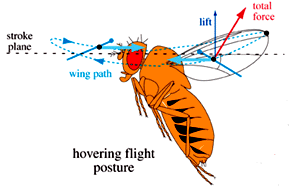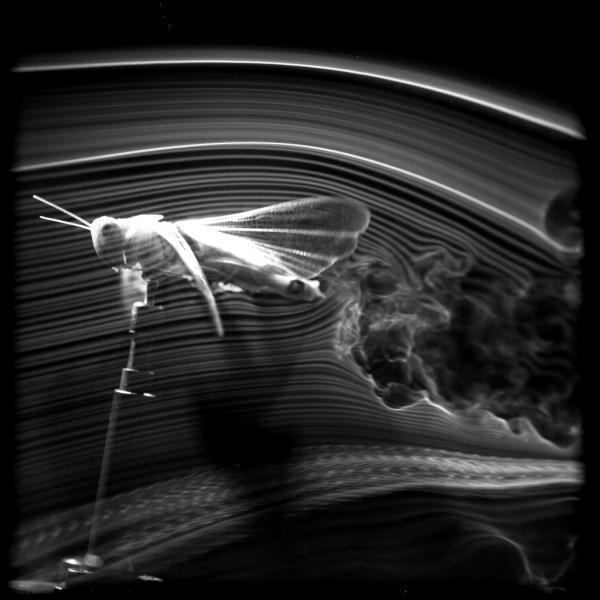How do insects stay in
the air?
A series of experiments
done by Michael Dickinson and his co-workers at the University of
California Berkeley used fruit flies (Diptera: Drosophila) and a
large scale Robofly wing in oil to answer this question.
By watching the live
flies researchers divided each stroke of an Insect's wings into
two translational phases and two rotational phases.
Translational phases, one up and one down, are where the insect
would push their wings through the air generating force.
Rotational phases, pronation and supination, involve rotational
movement of the wings in order to ready the insect's wing for the
next translational phase.
The same UC Berkeley
researchers then used the large-scale Robofly wing in oil to
determine the estimated magnitude and direction of the forces on
the wing (red arrows in the image below) as well as the forces
created by the insect (blue arrows in the image below). Oil
was used in order to simulate the effects of air on the fruit fly
wing relative to its actual size.

Image showing the forces
on and created by a fruit fly wing
http://www.scientificamerican.com/media/inline/00029B82-5453-1C75-9B81809EC588EF21_arch3.gif
The result was the
discovery of three ways in which insects are able to sustain
flight through lift.
Delayed Stall, Rotational
Circulation, and Wake Capture
More details and video (off site links)
Another series of
experiments preformed by Dr. John Young of the University of New
South Wales, Australia in collaboration with researchers from
Oxford University placed locusts (Orthoptera) in a wind tunnel and
filmed them with high-speed digital cameras. Locusts were
chosen because they have incredible conservation of energy during
flight as evidenced by their ability to fly large distances with
extremely limited energy reserves.
"Until very recently it
hasn't been possible to measure the actual shape of an insect's
wings in flight – partly because their wings flap so fast, and
partly because their shape is so complicated." - Dr. John Young
The results of their
research showed how the shape of a locust's wing changed during
flight. These changes are extremely important in
counteracting the Force of gravity (F=m*g) on the insect by
allowing it to generate maximum lift.

Smoke visualization of
locust in wind tunnel
http://www.sciencedaily.com/releases/2009/09/090917144125.htm
Practical applications of
this research included creating a computer model which allows
researchers to see a replicated airflow and the resulting thrust
generated by the locust, and to disprove the 'bumblebee paradox'
which states that insects defy the laws of aerodynamics.
This computer model will also be useful in developing insect-like
micro-air robots such as Robofly.
"The message for
engineers working to build insect-like micro-air vehicles is that
the high lift of insect wings may be relatively easy to achieve,
but that if the aim is to achieve efficiency of the sort that
enables inter-continental flight in locusts, then the details of
deforming wing design are critical." - Dr. John Young

